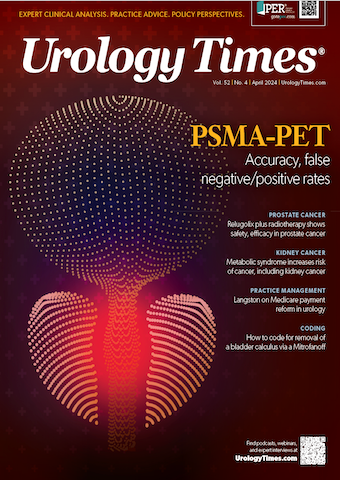Feature
Article
Urology Times Journal
Dr. Langston on Medicare payment reform in urology
Author(s):
In this interview, Joshua Langston, MD, highlights a session on Medicare reimbursement reform from the 7th Annual AUA Urology Advocacy Summit.
In this interview, Joshua Langston, MD, highlights a session from the 7th Annual AUA Urology Advocacy Summit titled, “Medicare Payment Reform: Fixing Physician Pay Now and for the Future.” Langston is the managing partner and CEO at Urology of Virginia and faculty at Eastern Virginia Medical School in Virginia Beach, VA.
Joshua Langston, MD

Could you recap the AUA summit session on Medicare payment reform?
The session was built around the ongoing awareness of the fact that the Medicare payment system for physicians is very broken. Part of our efforts on Capitol Hill were to go and speak to our legislative offices about our view from the ground level, the impact the system is having on our practices, and the impact on the future of health care in our country. The problem is that over the last 20 years, just to use that timeframe, it has evolved that everyone else in the health care space who are paid through the Medicare system, which would be inpatient hospital, nursing home, outpatient hospital, etc., all receive an inflation-related increase in their payments year over year, just to track with inflation. That's about 3% or 4% increase annually. For whatever reason, physicians were excluded from that annual increase. So, our pay has actually gone down or stayed level in real terms. When you consider the impact of inflation, we've taken essentially a 26% pay cut, relative to what we were being paid for the same services 20 years ago. The impact that has had is very much destabilizing our ability to run our practices, because the physician payment, interestingly, is not just the payment that comes to me personally as the physician, but it's the payment that comes to my entire organization.
We're a large group that has well over 250 employees, and that payment for the services that I provide has to cover all of those employees' salaries and benefits, and rent, and all the other expenses of running a medical practice. In light of the fact that all of those numbers have gone up (i.e, employee wages, rent, supply costs, software, and EMRs), those numbers have all gone up over the last 20 years, but our pay has remained flat, and relative to inflation has gone down significantly. That has led to a lot of independent practices closing and having to merge and become part of hospital systems, or private equity platforms. The ultimate effect of that is limiting access, because a lot of times it's those smaller independent practices that are out in communities that are more likely to be in rural areas or small towns that ultimately close down and have to relocate their practices into being part of a more major medical center or hospital system. So, it decreases access for patients, especially out in communities, and we're talking Medicare patients. We're talking elderly patients who oftentimes have transportation struggles or multiple medical problems that make travel difficult. It limits their ability to get the care that they need.
It also drives up the cost to the health care system in general, because since hospitals are paid more for the same services, as I described, they've been getting that rate increase every year. So at this point, they're paid much more for the same work than an independent physician is paid. That effect drives up overall costs to the health care system. It provides a huge amount of instability, because we never know year in and year out what we're going to be paid. We have to hope every year that whatever cuts are slated to happen, that Congress will find a way to mitigate that or stave off the cuts. You can't really run a business, which essentially a medical practice is at the end of the day–a small business–when you have so much uncertainty around what you're ultimately going to be paid for the work that you do year in and year out.
We were focusing on the problem and looking at potential solutions. There are a couple of bills in Congress. One effort, of course, is to stop the short-term cut. We're supposed to receive the 3.7% cut this year for 2024. There's still an effort to overturn that. Then there's also more discussion about what a long-term fix would look like, and actually reforming that and indexing our pay to inflation as all the other recipients have their pay indexed to inflation.
Could you touch on the LUGPA advocacy efforts surrounding Medicare reimbursement reform?
I would not say that LUGPA's ultimate goal is any different than everyone else's ultimate goal, which is to reform the system into a way that there is stability and predictability for our practices. We have and will during this congressional year advocate for the same bill, essentially, that everyone else is advocating for. It’s a bill introduced by Dr. Greg Murphy, a congressman from North Carolina, who happens to be a urologist, and his bill is the one that seeks to connect pay to an inflationary increase. LUGPA will be advocating for that bill as well.
What advice would you have for urologists who want to get involved with advancing the cause of Medicare reimbursement reform?
We're not going to single-handedly change votes and change minds, and balance budgets, and things like that. But we have to make it very clear to our legislators the impact that these decisions that they are making have on the practice of medicine within their district. We have to make it clear if there have been group practice closures as a result of not being able to make ends meet, if that has made access to care worse in their district, if their patients, their constituents, are having to travel hours and hours on end to get to appropriate care. They need to know that. It's very important that we connect with our legislators and share the realities of what's happening on the ground, in their district, with their constituents, and then project this going forward.
One other reality is that there are 11,000 people that turn 65 every day in the US. The number of Medicare recipients is increasing by 11,000 every day. Those patients are much more likely to need urology services because we largely treat an aging population. If we can't provide stability for practices now, what are we looking at 5 years from now? 10 years from now? The urologic workforce is going to drop off. We're going to have fewer doctors practicing because the financial instability is such that doctors that are close to retirement say, "okay, I'm just going to go ahead and retire," or "I'm going to close my practice and just work part-time doing some other form of urology; it's just getting too tough to try to work full-time in my practice." In the setting of more patients every day that need our services, we're faced with a decrease in the number of doctors and a decrease in the overall access to care because of these decisions that are in the hands of Congress. We really need to make it clear to them.
Is there anything else you want to add?
The solutions to the problems that we're facing, most importantly, are payment reform, payment stabilization. We have to be able to attract doctors to our field. If we are working harder and harder for lower and lower reimbursement and it's getting harder to make ends meet, then we're going to have a hard time attracting people in. Then there's going to be even more of an issue with access to care.
Burnout is a major issue. There was an interesting study that showed that the amount of work done by each individual doctor, so each full-time equivalent, each FTE, has drastically increased.1 The number of patients that the average FTE was seeing in a year went up significantly, by about 1500 visits. The number of RVUs, which is the metric of how much work is being done, went up quite a bit. What that says is that as pay is cut year after year, to make ends meet, doctors are doing more so that they can try to stay even. And they're doing it with the same amount of support. The same study showed that even though an average doctor is doing 1500 more patient visits than they were doing 5 years ago, they had the same number of support staff–so the same number of nurses or medical assistants. Yet they were they were doing so much more work, just to maintain a break even as far as the reimbursements. That is going to lead to burnout and further decline in the workforce. This idea that we can just keep doing more every year as they continue to cut our pay to our organizations is going to eventually lead to a disastrous situation. That data describes what is happening in reality in our country and the fact that it's very much unsustainable.
Reference
MGMA DataDive Cost and Revenue Data. 2018 and 2023. https://www.mgma.com/datadive/cost-and-revenue-data



























